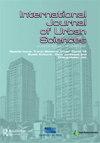Estimation of land surface temperature in response to land use/land cover transformation in Kolkata city and its suburban area, India
IF 2.9
3区 工程技术
Q2 ENVIRONMENTAL STUDIES
引用次数: 6
Abstract
ABSTRACT The land transformation in Kolkata city and its suburban area is mainly due to intensive population pressure and rapid urban sprawling. Consequently, the land surface temperature (LST) is continuously increasing and gradually intensifying the effects of the urban heat island. The aim of this study is to assess the spatiotemporal variation of LST in response to land use land cover change (LULC) during 1995–2020. The maximum likelihood classifier was used for the supervised classification of LULC and the accuracy assessment was done using the confusion matrix. Quin’s Mono-window algorithms for Landsat TM data of 1995 and 2010 and split-window algorithms for Landsat 8 OLI data of 2020 were applied to retrieve LST. Several spectral indices such as Normalized difference built-up index (NDBI), Normalized difference vegetation index (NDVI), and Modified normalized difference water index (MNDWI) were calibrated and pixel-specific overlay analysis was done for correlation study between spectral indices and LST. This work revealed that the rapid urban sprawling causes massive land transformation in the study area. The land conversions from trees outside forests (TOF) and agricultural land to built-up were significantly contributing to an overall increase in the mean LST during 1995–2020. The mean LST was comparatively high over Kolkata city than its suburban area. During 1995–2020, the mean LST was increased by nearly 8.43°C in the summer season and 4.32°C in the winter season. The increasing rate of LST was found relatively high over the built-up (7.06°C), agricultural land without crop (5.55°C), and open land (5.54°C). However, it was comparatively low over TOF (4.66°C) and water bodies (3.68°C). The LST was positively correlated to NDBI and negatively correlated to NDVI and MNDWI. In order to combat urban warming, this study will promote green city initiatives through sustainable land use planning.印度加尔各答市及其郊区土地利用/土地覆盖变化对地表温度的估计
摘要加尔各答市及其郊区的土地转型主要是由于密集的人口压力和快速的城市扩张。因此,地表温度(LST)不断升高,并逐渐加剧了城市热岛效应。本研究的目的是评估1995-2020年间LST对土地利用-土地覆盖变化(LULC)的时空变化。最大似然分类器用于LULC的监督分类,并使用混淆矩阵进行准确性评估。Quin的1995年和2010年陆地卫星TM数据的单窗算法和2020年陆地卫星8号OLI数据的分窗算法被用于检索LST。校准了归一化差异建成指数(NDBI)、归一化差异植被指数(NDVI)和修正归一化差异水分指数(MNDWI)等几个光谱指数,并进行了像素特异性叠加分析,用于光谱指数与LST之间的相关性研究。这项工作表明,快速的城市扩张导致了研究区域的大规模土地改造。1995-2020年期间,从森林外树木(TOF)和农业用地到建成区的土地转换对平均LST的总体增加起到了重要作用。加尔各答市的平均LST比其郊区相对较高。在1995-2020年期间,平均LST在夏季增加了近8.43°C,在冬季增加了4.32°C。在建成区(7.06°C)、无作物农田(5.55°C)和开阔地(5.54°C),地表温度的增长率相对较高。但在TOF(4.66℃)和水体(3.68°C)则相对较低。地表温度与NDBI呈正相关,与NDVI和MNDWI呈负相关。为了应对城市变暖,本研究将通过可持续土地利用规划促进绿色城市倡议。
本文章由计算机程序翻译,如有差异,请以英文原文为准。
求助全文
约1分钟内获得全文
求助全文

 求助内容:
求助内容: 应助结果提醒方式:
应助结果提醒方式:


